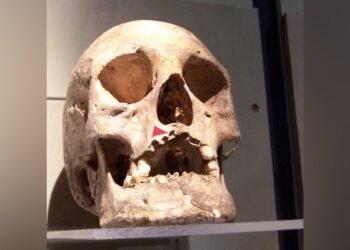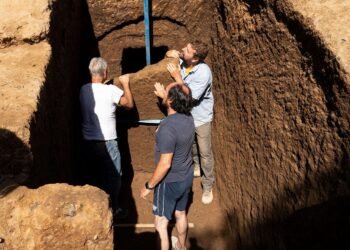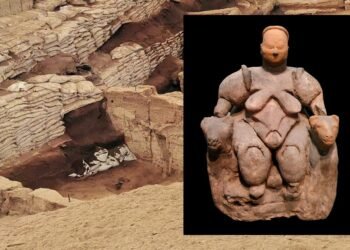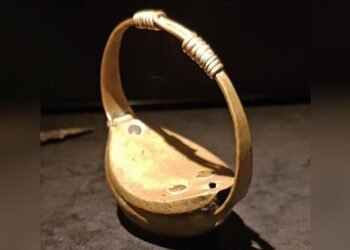In the ancient city of Tharsa, located near Kuyulu village along the Adıyaman-Şanlıurfa Highway in southeastern Türkiye, archaeologists have unearthed a remarkable Roman-era tomb. Adorned with two intricately carved bull heads, this 2,000-year-old tomb adds to the extensive Turuş Rock Tombs, a site of significant historical and archaeological interest.
Tharsa, an ancient city strategically positioned on a major Roman highway connecting Doliche to Samosata, features two settlement mounds and a large necropolis. The site’s historical importance is evidenced by its inclusion on the Tabula Peutingeriana, a late Roman map of the state road network. Excavations have revealed that the necropolis dates back to the 3rd century and continued to be in use into the Byzantine period.
The Turuş Rock Tombs are a distinctive type of tomb construction where the burial chambers are carved directly into the bedrock. This method involves descending 10 to 13 rock-cut steps to reach the main chamber, which often contains three arched niches known as arcosolia. The walls and doorways of these tombs are frequently adorned with various reliefs and decorative figures, reflecting the artistry and religious practices of the time.
In the latest excavation season, archaeologists have uncovered two additional rock tombs, one of which is the tomb with the bull heads. These heads, known as bucrania, are carved directly into the bedrock and are positioned to guard the entrance. Between the horns, the carvings are decorated with garlands and rosettes, further enhancing their intricate design.
The bull heads, symbolizing power and strength, have deep roots in Roman culture. They are associated with the god Jupiter, representing not only the deity’s might but also his role in purification and protection. In the context of the tomb, the bucrania were believed to serve as guardians, protecting the deceased from evil spirits and ensuring a safe passage to the afterlife. This practice also connects to ancient traditions where the heads of sacrificial oxen were displayed on temple walls as symbols of purification and rebirth.
The practice of including bucrania in tomb architecture is linked to broader Roman funerary customs, which evolved significantly over time. Initially, cremation was the predominant method of handling the dead, with ashes collected in urns after the body was burned on a funeral pyre. However, from the 2nd century AD onwards, inhumation became more common, influenced by diverse cultures integrated into the Roman Empire.
Funeral rites often included elaborate processions to the burial site, featuring family members, professional mourners, musicians, and ancestral masks to honor the deceased. These rites were designed to ensure a smooth transition to the afterlife, reflecting a blend of Roman religious beliefs and customs inherited from conquered territories.
The recent discoveries at Tharsa are part of an ongoing excavation project that aims to uncover and preserve the rich history of the area. The first significant excavations of the rock tombs were conducted in 1999, but it wasn’t until 2021 that a revitalization project led to the clearing of 10 acres of land, revealing 60 tombs with varying designs and motifs. This project resumed with renewed vigor in 2024, adding two more rock tombs to the existing collection.
Mustafa Çelik, Deputy Director of Adıyaman Museum, said, “Tharsa Ancient City consists of 3 main archaeological areas: Big Mound, Small Mound and Necropolis Area. We started excavations in the necropolis area in 2024. We added 2 more rock tombs to the rock tombs we had previously uncovered. One of them is the rock tomb we identified today.”
Çelik emphasized the potential of transforming Tharsa into a major tourist attraction, given its historical and archaeological wealth. To protect the newly discovered tombs from environmental damage, a new drainage system is being implemented to prevent rainwater runoff from seeping into the graves. Excavation and removal of soil and rocks from the graves will continue until September 2024.























